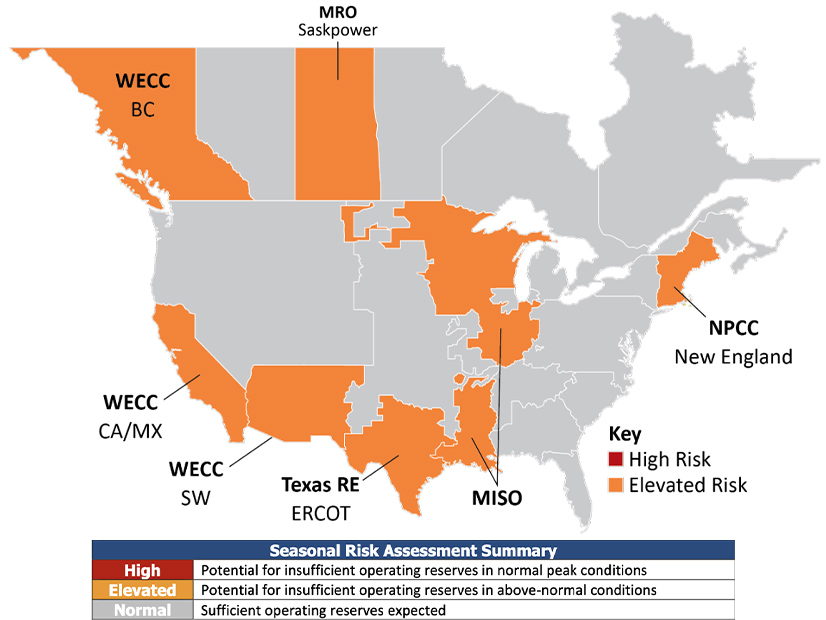NERC’s 2024 Summer Reliability Assessment, released May 15, found that every region has met its reserve margin targets but that many areas would face difficult operations in lengthy, widespread heat waves.
Wide-area heat events that affect generation, wind output or transmission systems coupled with demand growth in some areas are contributing to risks in some regions. The report lists CAISO, ERCOT, ISO-NE, MISO and the Southwest as facing elevated risks this summer.
Weather forecasts call for above-average temperatures in most of the country, with the greatest chances for hot weather in the Northeast, Texas and much of the Intermountain West.
“What we’re really seeing is a transformation of our system, but also the types of risks,” said John Moura, NERC director of reliability assessments and performance analysis. “And as we address one risk, other risks pop up. As we bring on more wind and solar, certain risks need to be mitigated and addressed. As we also retire resources, we need to think about some of the essential reliability services that we’ve traditionally received from resources.”
The changing grid has regions relying on their neighbors more than ever, as transferring power between regions can deal with some of those new risks that come with the changing generation fleet.
“We have now what we call wind droughts that are persistent and widespread, and these affect areas, and so we’re seeing a greater need to not only economically trade with our neighbors, but really be reliant, and then have confidence in advance that those transactions are going to be there and they’re going to be reliable,” Moura said.
All of the areas assessed have adequate supply for normal peak load in part because of major capacity additions since last summer. The industry has added 25 GW of solar capacity in the past year, which comes on top of 19 GW added the prior year, said Mark Olson, NERC manager of reliability assessments.
“Really significant amounts of” battery storage have been added “in ERCOT and in the California-Mexico assessment area,” Olson said. “These areas have a lot of solar resources, and so the batteries are particularly important resources capable of helping manage the variation … as the solar ramps down in the late afternoon and early evening but demand is still high.”
Growing demand is being felt most acutely in Texas and SPP this summer, Olson said.
MISO has seen some resource additions since last year, but those were offset by continued retirements and a cut in expected imports.
“Like last year, wind generator performance is really the key factor in MISO in its ability to meet reserves during high-demand periods,” Olson said.
ISO-NE no longer can rely on the natural gas power plant at the Mystic site outside of Boston, which makes its reserve margins lower than last year.
ERCOT continues to see large load growth, along with massive growth in solar energy capacity, though it still will face issues when the sun goes down and demand remains high. The key to reliable operations there will be running storage properly so it can be fully charged when needed most, Moura said.
“California, under an extreme condition, would be highly reliant on its neighbors,” Moura said. “That’s really how the Western Interconnection works. We’ve shown improvements since last year, probably primarily because of the improving drought conditions. And so, this year, it has a better chance of relying on its neighbors because there’s a little more availability of hydro.”
Most of the biggest issues with reliability in the past decade have come during the winter, but Moura and Olson said the summer still presents significant issues for grid operators. Demand can be very high in some regions because of the heat.
“In California, that demand can be really variable in the summer,” Olson said. “They have a lot of rooftop solar; it just has a peakiness about it. That makes for demand challenges.”
Winter has more supply issues, as the industry is competing for natural gas at its peak demand and extreme cold can lead to weatherization issues, he added.
Moura noted the addition of solar has helped significantly in recent summers.
“We’ve almost had a perfectly correlated resource that we’re building extremely fast. That’s correlated with peak demand for now, which is solar,” Moura said. “And so, this recent solar summer assessment shows for the peak hours that we traditionally have seen … we’ve got a great resource that can provide that for that particular peak. But almost every other hour throughout the year has challenges.”



